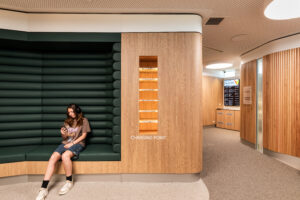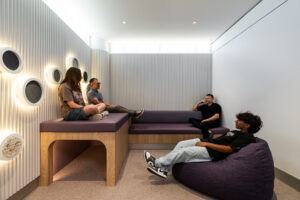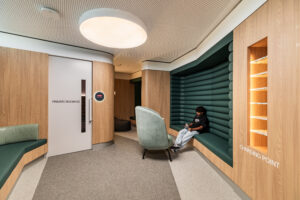PTT sits down with Darron Freegard, terminal planning and strategy manager at Perth Airport and co-chair of ACI’s World facilitation and services committee accessibility working group, to discover more about the expert insights he plans to share in the panel discussion – titled ‘From ‘why’ to ‘how’ – developing practical guidance for airport accessibility’ – at Passenger Terminal Conference 2025 (April 8, 9 & 10) in Madrid, Spain.

Please tell us more about your presentation.
People with disability often face barriers when traveling. The existing compliance-based approach to planning is not fit for purpose, and the facilities and services that airports provide must be accessible and barrier-free. Building on the ACI Airports and Accessible Travel: a Practical Guide, this panel moves the conversation from why accessibility is important, to how airports can do better in providing meaningful inclusion. This panel will highlight practical tools to enhance the experience for travelers and employees with disabilities while exploring how standardized practices can encourage more people to travel with confidence and unlock new commercial opportunities.

What are the biggest challenges airports face in improving accessibility?
Many practitioners view accessibility through the lens of an infrastructural challenge, which is without doubt a significant issue, particularly in legacy facilities and for those travelers with mobility issues for whom interventions to improve accessibility can be difficult.
The recent Australian Aviation White Paper identified the lack of coordination and facilitation of a true end-to-end travel experience as a significant travel barrier for persons with a disability. This is the result of multiple service providers, including airports, airlines and control authorities, being accountable for the delivery of the traveler’s journey. Greater collaboration is required by service providers to deliver a seamless end-to-end traveler journey tailored for persons with a disability.
We have also seen the importance of training airport and contractor employees to recognize specific needs and provide a consistently high standard of service to persons with a disability, particularly at the security screening point where interventions with travelers are often required. One poor experience at a touchpoint can permeate the entire journey, discouraging persons with a disability from traveling by air.
How can airport teams effectively implement accessibility guidelines and policies?
Accessibility guidelines and policies need to be championed and modeled by the airport leadership team to effect permanent and lasting change. Policies need to be grounded in defined, measurable and time-bound outcomes that demonstrably improve outcomes for disabled travelers. The recently published ACI Airports and Accessible Travel: A Practical Guide offers an excellent reference guide for airports seeking further guidance.
Actively engaging and consulting with the disability community and those with a lived experience to provide advice and guidance on disability policy and priorities, through a formal reference or co-design group or other forum, is also strongly recommended.

Accessibility outcomes need to be clearly identified from the inception of facilitation projects to convey their importance to design teams, and unambiguously reflected in project objectives. Perth Airport has developed subject-matter guidance as a specific airport design and technical standard that goes beyond complying with the prevailing legislation to signify its importance and drive a consistent approach across all airport development.
In our experience, an understanding of the wider benefits of accessibility for the broader traveling community, together with debunking commonly held beliefs that accessibility is expensive through education and awareness among those responsible for policy implementation, is a further critical success factor.
What role does technology play in enhancing airport accessibility?
Technology is enabling more personalized experiences for all travelers. Travelers will continue to adopt technology, such as assistive technology, that works for them, and expect this to be understood and supported in airport environments like any other environment. Technological interventions such as navigation aids for visually impaired persons or automated wheelchair trials by a number of airports can make a real difference to travelers with specific disabilities.
However, technology is not a panacea for the improvement of the travel experience for everyone with a disability. Like other parts of our lives, personal preferences need to be accounted for, so they should be seen as complementary to a broader adoption of universal design. Focusing on barrier-free travel principles in the design of airport facilities will ensure they make air travel as accessible to as many people as possible, regardless of ability, ultimately benefiting all travelers.
How do you envision the future of inclusive airport design?
The starting point for inclusive design is to recognize that compliance with the relevant legislative standards is just the beginning. Persons with lived experience, not just advocates for the space, need to be actively engaged and consulted to gain a real understanding of their needs and desired outcomes. Accessibility needs to be recognized as being as central as the provision of power, water and wi-fi in the design of the building and not simply something that is considered at the end of the design process.

What are the key trends driving the improvement of accessibility for passengers with diverse needs?
There is a growing awareness of the need to improve accessibility to transportation for persons with disabilities, in part informed by the evidence provided to governments – for example, the Australian Disability Royal Commission. These findings identified the hardships people experience and foreshadowed the strengthening of legislation to address the barriers faced.
Many countries are also experiencing rapidly aging populations with attendant diverse and often complex medical needs and cognitive and mobility difficulties that are beginning to inform airport design.
Developments in technology, such as electric batteries and self-guided vehicles, are also driving solutions that are helping persons with disabilities overcome barriers to travel and gain additional independence that until recently would have been extremely difficult.
Airports are also increasingly recognizing the importance of a social license to operate and the need to ensure they are delivering better travel outcomes for all members of the community they service.
Finally, disability is being increasingly recognized as not simply a limitation of physical ability. The importance of accommodating the needs of the neurodiverse community is being reflected in airport design and employee training. Together, these factors are driving improved outcomes for disabled travelers across an increasing number of airports globally.

Is there anything else you’d like to add?
Adopting a compliance-based approach to the design of airport infrastructure will not deliver truly accessible airport facilities for persons with disabilities. Facilities should be designed from the outset using principles of barrier-free travel and universal access rather than simply making adjustments to facilitate compliance with legislation, important as that is. According to a UN Department of Economic and Social Affairs (UNDESA) study, such an approach is no more expensive and delivers outcomes not only for those who identify as having a disability but for all travelers regardless of ability. The barriers that disabled travelers face go beyond the physical environment, so it is as important to consider social and attitudinal barriers through a process of education, training and awareness of all airport employees to deliver a great airport experience.
Finally, a key challenge for our industry is reconciling the feedback from people with disabilities with those charged with the design, development and operation of airports. The risk is that we focus on addressing a relatively narrow range of those barriers experienced by well-advocated disability groups to the exclusion of others, for example, those with non-apparent disabilities. For these reasons, it’s critical that our industry works collaboratively with ICAO to develop aviation-specific standards that reflect the unique characteristics of airport environments.
To hear more valuable industry insights from top aviation executives, book a conference pass for Passenger Terminal Conference, taking place on April 8, 9 & 10, 2025, in Madrid, Spain.



